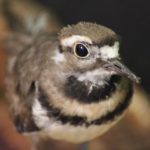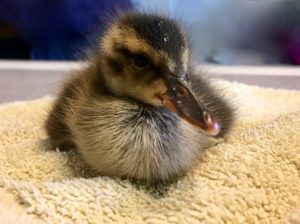Found injured or sick wildlife?
We have housing and resources available To Care for:
Native small mammals & waterbirds & REPTILES
*** No Songbirds ***
Any drop-offs to our partners need to be confirmed by us first!
IF NONE of our DROP-OFF PARTNER IS AVAILABLE, EMAIL US TO MAKE alternative arrangements
COMMON Okanagan WILDLIFE Questions
small Mammals:
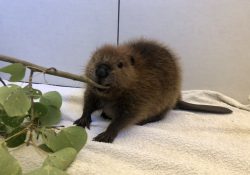
Beavers
Beavers and other semi-aquatic mammals are complex species to rehabilitate due to their unique social and health needs. Interior Wildlife is one of the few rehabilitation centers in BC equipped with an aquatic facility to house and care for mammals year-round (such as beaver or river otter). If you've found and injured adult or displaced beaver kit, please take a picture of the animal and its surroundings. Then email us for further directions before you do anything.
For any questions about our beaver co-existence program, go to our: Wildlife Info, then hit the "Beaver Human Coexistence" tab.
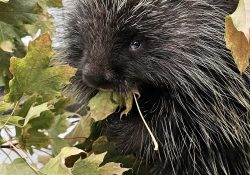
Porcupines
Another local large rodent is the porcupine. A very peaceful and slow moving herbivore living in our forested neighbourhoods. Okanagan porcupines (adult or juvenile) commonly get injured on roads, sometimes by pets. Please contact us first if you believe that a porcupine needs human care. They have 30.000 reasons for you to not touch them!
We can certainly house and treat porcupines. However, a baby porcupine below a tree where its mother is feeding is a common sight and doesn't mean it is orphaned. Notify us as soon as possible via email if you find an injured porcupine.
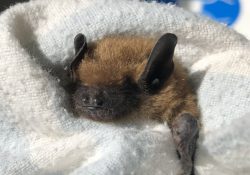
Bats
A lot of insect-eating bats are native to the Okanagan. Displaced, cold or young grounded bat pups that may be learning how to fly and commonly have difficulty taking flight off the ground. Usually they crawl to a vertical surface, to be able to take flight when it gets dark outside.
If you see a grounded bat or bleeding bat, a bat with a broken bone or torn wing membrane, please call the Okanagan branch of BCbats program:
1-855-922-2287 (ext 13)
and obtain further directions BEFORE touching the animal.
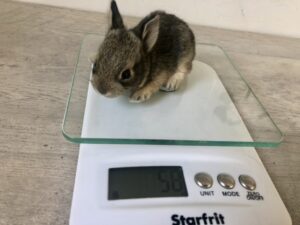
Cottontail Rabbits
Native wild cottontail rabbits sometimes get injured by pets or their nests get displaced by construction. If any juveniles you have found are not injured, the best course of action is to put them back where found so the mother can find her young. Mother rabbits leave their babies but come back to nurse them in the evening. If you have to add nesting materials or make a new “makeshift nest” close to where you’ve found a destroyed nest. We do NOT advise to check frequently in person as this will stress out this illusive and high-stress species. Wild juvenile wild rabbits have the best chance of survival if raised by their own parents. They do very poorly in human care and are very much unlike domestic rabbits that would thrive in captivity.
If the mother is seen dead (hit by mower, hit by car or bit by pets such as cats or dogs), please email us for further directions. Always include a picture and ideally a weight for wild rabbit inquiries.
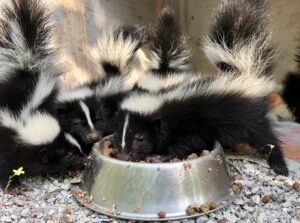
Skunks
Sometimes skunks make their nests under human structures. Unwanted skunks can easily be excluded to avoid this. Here is how you can help:
1. To reunite mother & young, give adult female access to babies. She will "relocate" her nest to an alternative spot within her territory herself.
2. To evict and exclude adult skunks that may be looking at nesting under a porch or in a shed. You can call a "wildlife control contractor". We are happy to give you reputable and humane contacts.
Truly orphaned skunk kits can be collected if the mother has been seen dead. A lone baby skunk that can fit into the palm of your hand is not a normal sight. Email us for further directions.
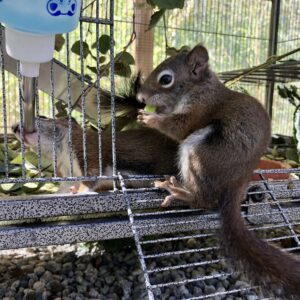
Red Squirrels
Squirrels species we may rehabilitate and release are: red & pine squirrels, as well as chipmunks & northern flying squirrels. More info on squirrels in the FAQ's section below! Note that we are required to release squirrels within a 10km radius of it's place of origin.
Note: We are NOT permitted to rehabilitate gophers & invasive grey squirrels. Greys are twice the size of native squirrel species and can be grey or black in colour. If you are unsure what type you have found, email us a picture and ideally a weight.
other Mammals:
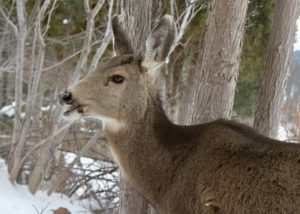
Adult Deer
Please know, that injured ADULT deer are never candidates for rehabilitation in BC. This is due to their high stress levels in captivity (and a fatal condition „capture myopathy“). Adult deer are very likely to develop this life-threatening issue when handled or captured for care.
Please note: Interior Wildlife is NOT permitted to rehabilitate deer
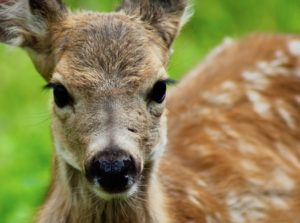
Fawns
Deer fawns are left alone (for 6-8 hrs/day) by the doe (their mother) for the first 2 wks of their life. Most fawns are intentionally left (or hidden from predators) by their mothers who are foraging for food. She returns to feed her fawn a few times a day (usually at dusk & dawn). Disease transfer amongst deer in our valley is a concern, which led to the local authorities prohibiting rehabilitation for deer fawns in the Okanagan (deer of any age are susceptible to "Chronic Wasting Disease" and testing is not possible on live animals).
Please note: Interior Wildlife is NOT permitted to rehabilitate deer fawns
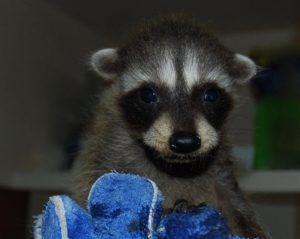
Raccoons
Rehabilitation and release of raccoons is banned in the Interior of BC by the local government.
Currently, the only option to help severely injured racoons is humane euthanasia. However, simply displaced or unwanted raccoons have more options. Here is how you can help:
1. To reunite mother & young (give adult female access to babies). She will "relocate" her nest to an alternative spot close-by.
2. To evict and exclude adult raccoons that may be looking at nesting in your attic and raising their young in a human house.
Please note: Interior Wildlife is NOT permitted to rehabilitate raccoons.
We care for:
our permitted Species only
Aquatic birds:

Geese
Waterfowl such as native Canada Geese often get leg or wing injuries. Note that sick geese don’t always show signs of bird flu but can still infect other birds and die suddenly.
If you have found an injured goose or gosling, email us first, as we are limited to how many we can take in due to strict bird flu biosecurity protocols. If a gosling is injured (e.g. bleeding or laying flat on ground), please collect it and email us for further directions.
Please note: Interior Wildlife does NOT raise goslings that are already imprinted on humans
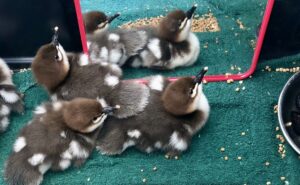
Ducks
There are over 20 types of ducks in BC. Some are found injured by human activity, including fish hooks. Accidents happen. In spring and summer we often see mallard ducklings separated from their parents.
Watch the duckling(s) for at least 1 day to determine if truly orphaned, did you see the adult being killed? Are there other ducklings or is it alone? Where are they located (trapped in a window well, hatched on a roof in a planter box etc.?).
If an adult duck or young duckling is injured (e.g. bleeding, laying flat on ground or holding a wing in an abnormal position), please collect it and email us for further directions. Note: No water or food!
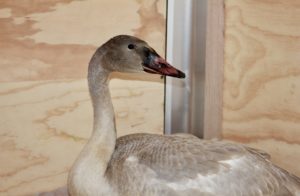
Swans
Often waterfowl such as native Trumpeter or Tundra Swans get leg or wing injuries. Note that sick swans don’t always show signs of bird flu but can still infect other birds and die suddenly.
If you have found an injured swan or young cygnet, email us first, as we need to ensure its capture will be done safely for humans & animals.
We can certainly house and treat native swans, but capture needs to be done responsibly. Notify us as soon as possible via email.
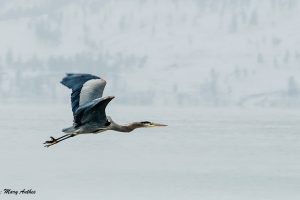
Herons
Often large wading birds such as Great Blue Herons sustain leg or wing injuries. Sometimes they are malnourished and lethargic or suffer from extreme heat in the Okanagan.
If you have found an injured heron or a lone and immobile or lethargic heron chick on the ground, email us for further directions prior to attempting capture of any herons.
We can certainly house and treat herons, but capture needs to be done responsibly. Notify us as soon as possible via email.
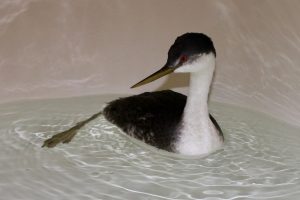
Grebes
Western and horned grebes can get grounded/found off water (esp. in the winter). They are diving birds that have to live on the water due to their unique physiology. Grebes can't take flight from or walk on land. If you have found a grebe on land, please contact us as we are limited to how many we can house "on water" in our deep diving pools and the season of admission is a deciding factor too. Diving birds such as these should not be housed on land for over 24hrs and gloves are mandatory to touch them in order to not ruin waterproofing. Please beware of sharp beaks they will use as a spear when approached by humans.
Notify us as soon as possible via email.
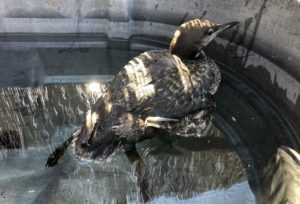
Loons
Often diving birds such as loons get foot injuries if they spend any time on land by accident. Loons can't take flight from or walk on land.
If you have found a grounded loon off the water, or a lone loon chick, please email us for further directions. Avoid touching aquatic birds without gloves (to protect their waterproofing) and beware of sharp beaks they will use as a spear when approached by humans.
We can certainly house and treat loons, but capture needs to be done responsibly. Notify us as soon as possible via email.
other birds:
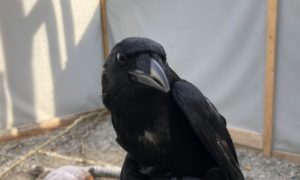
Corvid Birds
How to help young crows & ravens & jays in spring?
Step 1: Place the fledgling in a shady spot (preferably a bush) within earshot of where you found it or where you see or hear adult birds of the same species. Give it space for the rest of the day.
Step 2: If the fledgling has not moved within 24hrs, please contact us and await directions before bringing the bird indoors.
It's not springtime and you’re certain the bird is injured - What now?
If it is bleeding or holding legs, wings or feet in an abnormal position, maybe a bone is sticking out through the skin, then please collect the bird and send us a picture of the injury for further directions.
Not sure if it is a young or an adult bird?
Gently lift a wing and look for “pin feathers” that look like “straws”, send us a picture and await directions. Important: NO food or water!
Please note: Interior Wildlife does NOT rehabilitate corvids. We may stabilize some ravens and crows for transfer if resources allow.
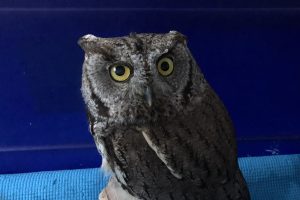
Raptors
Raptors such as owls, hawks, osprey, vultures and eagles are "birds of prey". At our facility in Summerland we do not have housing for conditioning raptors which hunt "on the wing". We can stabilize an injured raptor under certain circumstances, but we do not have large raptor flight pens. Once stable, we will transfer to other licensed rehabilitation centres that are equipped with raptor-specific outdoor housing these birds need to get fit for hunting and survival in the wild again.
Please note: Interior Wildlife does NOT rehabilitate raptors. We may stabilize some raptors for transfer if resources allow.
Picture source: Western Screech Owl that we have stabilized short-term at Interior Wildlife

California Quail
If you find a California quail chick by itself, DO NOT BRING IT INSIDE for more than 24hrs, unless it is soaking wet. Instead place the chick in a shady and dry spot (preferably under a bush) within earshot of where you hear adult quail. Quail chicks will likely run with other adult quail, they will readily adopt unrelated chicks.
Wild quail (chicks or adults) do not do well in captivity as they are a high-stress species and success rate for survival is drastically reduced if kept confined.
Did you know?
Several California quail broods may mix after hatching, and all the parents care for the young. This is despite high quality care by a wildlife rehabilitator, with specialized insect-diet, incubators and meticulous heat as well as humidity control.
If the chick is lethargic and not standing up or running, if it is wet or covered in blood, you may email us for further directions.

Sick Aquatic Birds & Avian Influenza (HPAI)
To report aquatic birds such as sea gulls, geese, swans, ducks, herons - with neurological symptoms
(strange behaviour without obvious injuries, such as falling over or head circling without obvious injuries)
please call: 1-866-431-2473.
Speak with Environment Canada responsible for migratory birds.
Environment Canada officers give priority to reports of 3 or more dead birds (of any avian species) found in the same geographic location. Report your findings, chances are that there are more in the same area.
If you see a bird displaying any strange behaviours, assume it has been infected and keep your distance unless instructed otherwise by a veterinary or wildlife professional.
Read more info about the HPAI virus in our:
Found a dead wild animal?
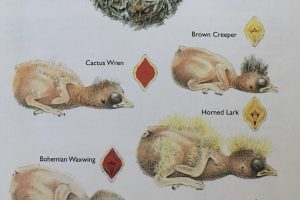
Baby Songbirds
Songbirds that are not fully feathered need their parents to survive. If you find a naked baby bird on the ground, the best course of action is to put it with the nest up off the ground again. Choose a location close to where you’ve found it (within earshot distance), affix it on a post or a branch away from access by cats.
Trust that the parents will come and continue to feed their offspring.
Alternatively, you can also use a berry basket and line it with grass, if the nest is too broken or can’t be zip-tied to anything.
Please note: Interior Wildlife does NOT rehabilitate songbirds (baby or adult).
Picture source: "Nests, Eggs and Nestlings of North American Birds" by Baicich & Harrison
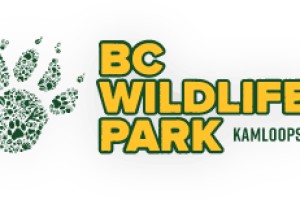
Adult Songbirds
Often songbirds strike windows or get caught by cats. The closest licensed rehabilitation facility that cares for songbirds is in Kamloops , at the BCWP (250-573-3242 ext. 230).
Most years the BCWP doesn’t have resources to accept naked nestlings. Please be aware that all wildlife rehabilitation centres will ask you to transport the animal to them yourself.
Unsure what type of bird you have found? Email us a picture, we help to identify the bird whenever we can. This may help decide if driving to Kamloops is indicated for the animal you have found.
Please note: Interior Wildlife does NOT rehabilitate songbirds. The rehab department of the BC Wildlife Park in Kamloops covers adult songbirds of native species.
REPTILES:
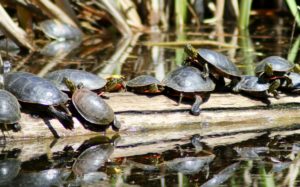
Turtles
Our native western painted turtles often get injured by unsupervised dogs, hit by cars or swallow fish hooks by accident. If you have found an injured painted turtle, please email us and remember to include a picture of it's underside for species identification to: info@interiorwildlife.ca
Note: "Red-eared Sliders" (are an invasive, they have a yellow plastron/belly). We do not care for invasive turtles.
Native "Painted Turtles" have vibrant red colour on their plastron/belly.
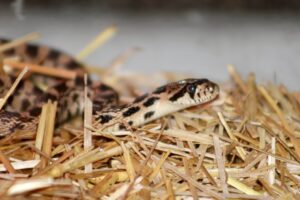
Snakes
We have 7 species of snakes in the Okanagan. They can get injured by unsupervised dogs, entangled in garden nets or woken up from their hibernaculum/nest. If you have found an injured native snake,
please email us before touching a snake
(remember to include a picture of it for species identification).
We can certainly house and treat native snakes, but capture needs to be done responsibly and lots of snake species are protected in our valley. Notify us as soon as possible via email before you do anything.
More info on our valley's snakes and how to live with them safely and respectfully at: Okanagan Similkameen Stewardship (www.osstewardship.ca/snakes)
Choose one of the following options:

FOUND WILDLIFE THAT NEEDS OUR CARE?
Email us, please include:
1) Your location
2) A picture of the animal
3) Why human care is needed?
4) Have you captured & contained the animal already?

HAVE A CRITICAL WILDLIFE EMERGENCY?
Call the RAPP hotline:
1.877.952.7277
For info and reporting on wildlife involving public safety (large carnivores & deer) speak with a Conservation Officer

WANT TO ARRANGE A WILDLIFE DROP-OFF?
Call one of our local veterinary partners:
Our veterinary partner clinics are available to receive pre-arranged wildlife drop-offs during their respective business hours.
See vet contact list below:

HAVE A GENERAL WILDLIFE QUESTION?
Call the BC SPCA hotline:
1.855.622.7722
For info on different species, conflict situations, general urban wildlife questions
(advice on wild and domestic animal questions across BC)
CLICK ON A QUESTION BELOW TO SEE our Wildlife FAQs
Rehabilitation FAQs:
No. Never attempt to raise wildlife yourself. It is illegal in BC to keep wild animals in captivity for more than 24hrs without a permit. All wildlife require specialized care if they are to successfully recover and be released back into the wild. Stress from captivity and shock from improper handling are major killers. Some injured and stressed wild animals can cause serious injuries to handlers. Survival depends on prompt and knowledgeable response. Ask a licensed wildlife rehabilitator for help! A person with experience in raising wildlife, DOES NOT make them a licensed rehabilitator. Permits are required for every wildlife species. For example migratory bird care requires a license from Environment Canada.
To ensure the safety and health of people and wildlife, members of the public should generally avoid handling wildlife uninstructed. Wild animals can inflict serious injury and can be carriers of disease and parasites that are transmissible to humans and domestic animals. You should not attempt to assist a sick wild animal if there is a risk to personal safety or the safety of others. Ask a licensed wildlife rehabilitator for help, do not do anything uninstructed! We answer our emails 7days/week for that reason.
Mammal FAQs:

No. Rehabilitation of adult deer is prohibited. Please know, that injured ADULT deer are not candidates for rehabilitation in captivity. This is due to their high stress levels as a prey species, and a fatal condition that they are very likely to develop when handled or captured for care, even short-term (called „Capture Myopathy“).
If you have observed that the adult deer you’re seeing is bleeding, has legs/body parts out of place, entrapped, or got entangled in foreign objects, call the RAPP line service to speak with a local Conservation Officer (CO), phone number: 1.877.952.7277. We have been instructed by the Ministry of Forestry to advise the public to call the RAPP line (connected with COs) when deer inquiries reach us.
The mandate of the Conservation Officer Service (COS) is public safety and wildlife/hunting/fishing/pollution law enforcement, not wildlife care or population management. Our local veterinarians are not allowed to rehabilitate wildlife, their mandate is to medically take care of pets, not wildlife husbandry.

Deer fawns are left alone (for 6-8 hrs/day) by the doe for the first 2 wks of their life. Most fawns are intentionally left (or: hidden from predators) by their mothers who are foraging for food. Fawns don’t have a distinct scent, so they’re safer left hidden opposed to constantly staying with the doe. She returns to feed her fawn a few times a day (usually at dusk & dawn). See more info on fawns under “You’ve found injured or orphaned wildlife, now what?” here: https://www.bcwildlife.org/injuredwildlife.htm
Please note, that the management of deer is mandated by provincial laws and rehabilitation of deer fawns is actually not permitted by the government authorities in the Interior (Okanagan & Thompson Regions). Disease transfer amongst deer in our valley is a concern, which led to the local authorities prohibiting rehabilitation for deer (deer of any age are susceptible to “Chronic Wasting Disease”).
Other licensed rehabilitation facilities which are allowed to care for deer fawns are only permitted to accept a small number of deer fawns (should the mother have been witnessed to be dead/hit by car). However, they can only admit fawns of their region, e.g. in the Kootenays, not from the Okanagan. There is no wildlife rehabilitation centre permitted to care for and release fawns in the Okanagan Valley.

Small mammals may need help, if you see:
- It appears to be covered in bugs
- Disorientation/uncoordinated movement
- Lethargy
- Wounds/ bleeding/ maggots in wound
- Missing lots of fur, or if the fur appears contaminated
- Caught by a cat (seen or suspected)
- Hit by car/farm equipment
- Limping or appears to have any improperly positioned limbs
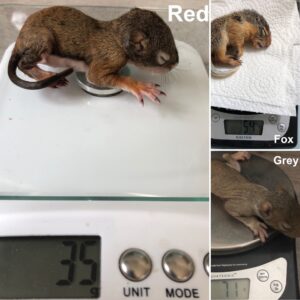
Please find out what type of squirrel it is: grey, red, fox or northern flying.
All young squirrels open their eyes at about 4 weeks of age and should be furred. Our native squirrels are a lot smaller as juveniles compared to invasive grey’s. If you are unsure, you’re welcome to send us a picture and a weight of the animal. We’ll be glad to assist in telling you what you have in front of you: info@interiorwildlife.ca.
If it is a native red or flying squirrel, now organize transport & email us:
All wildlife rehabilitation facilities in BC rely on the public to transport animals in need to them, as we operate mainly with volunteers and have only enough human resources to tend to the animals brought in. No pick-up service. No wildlife ambulance.
If it is an invasive grey squirrel please email us to get further direction.
Note: The public is legally only allowed to keep any wildlife in distress captive for up to 24hrs (regardless of the species).
Wildlife centres receive many calls each year about baby small rodents who have been “orphaned” after a nuisance mouse was trapped or relocated. Sadly, we don’t have the resources to take care of them, and many are turned away. This is also partly due to the fact that their chances of survival after release would be too low. If the habitat of the mice you’ve found was a house, you surely do not want to release them there again (read more: https://www.torontowildlifecentre.com/wildlife-emergency-rescue-hotline/conflicts-with-wildlife/common-rodent-problems/rodent-trapping/). It’s unlikely that most relocated small rodents will survive long in their new environment, even if it sounds nice to us humans to release small rodents to a park or a forested area. The best thing anyone can do is to prevent this endless cycle of unwanted house-rodents from happening by addressing the root cause, removing food attractants & removing any entry points, read more: https://www.torontowildlifecentre.com/wildlife-emergency-rescue-hotline/conflicts-with-wildlife/common-rodent-problems/mice-in-house/. Inform your family and let others know how to prevent human-rodent conflicts at home. |
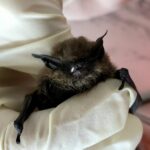
In the winter our native bats are hibernating. They may get aroused from torpor occasionally when the weather warms for a few days and fly in search for a drink at night. This is normal.
An injured bat will hold a wing in an abnormal position, bleed or be entrapped without an escape route to the outdoors. Usually bats crawl to a vertical surface to be able to take flight. Remember: Do not handle bats without leather gloves. We’re happy to answer your bat questions. Simply email us!
For more bat info: There is an Okanagan bat conservation group in BC with a great educational website about all things related to local bats: https://bcbats.ca/
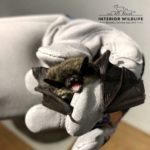
If you are seeing a little bat on the ground, it may be having difficulty taking flight. This can be due to injury, a sudden drop in outside temperature or disorientation inside a building. Usually bats crawl to a vertical surface to be able to take flight. Remember: Do not handle bats without leather gloves. We’re happy to answer your bat questions. Simply email us!
For more bat info: There is a bat conservation group in BC with a great educational website about all things related to local bats and why they are important. Find them here: https://bcbats.ca/
Generally, good info on what to do if you’ve found a bat that isn’t flying away by itself – look here: https://batworld.org/what-to-do-if-you-found_a_bat/
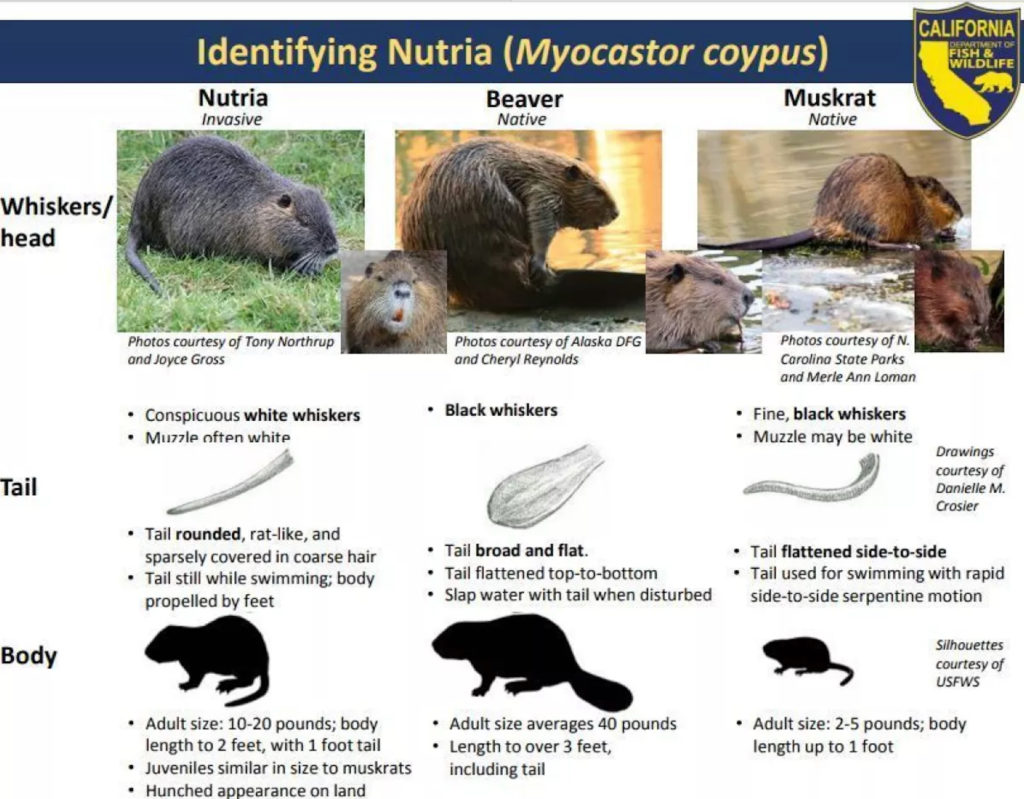
Nutria (non-native)
Please note our permits do not allow us to rehabilitate nutria (“white whiskers”).
If you need help with muskrat or beaver, please email us here: info@interiorwildlife.ca

Reunite families
To reunite mother & young (give the adult female access to her babies). Caution: raccoons can carry serious diseases that are zoonotic (we can get sick by touching them or their feces). Always wear gloves when handling this species!
How about we relocate?
Relocation of any kind of wildlife has been proven to be a controversial and outdated option to deal with human-wildlife conflicts.
Reasons include: spreading of species-specific diseases amongst territories of established populations & fights amongst individual wild animals resulting in intruder eradication by established wildlife, and: new animals taking over the area where an unwanted animal was removed from… etc.
What can you do?
We discourage any kind of wildlife feeding (including access to garbage), this usually attracts various species of animals and more often than not causes human-wildlife conflict. The raccoon family WILL move on once the juveniles are weaned and able to forage for food by themselves (end of summer). THAT IS YOUR WINDOW to close any gaps, holes, entryways to your house/shed to prevent this raccoon mother to give birth and raise more babies next year in the same spot.
We applaud any action you may be willing to take, in living peacefully with this raccoon family and educating others. We do not consider raccoons “pests”, however we are aware that officially they are labelled as such in our region. See more info here.
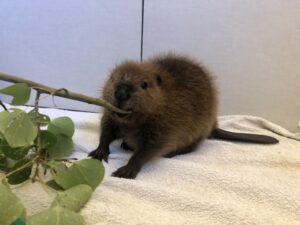
Interior Wildlife is one of the few licensed rehabilitation centers in BC equipped with an aquatic facility to house and care for aquatic mammals year-round (such as beaver or otter).
If you’ve found and injured or displaced beaver, please email us first, before attempting to collect the animal. We will give you further directions promptly 7 days/weeks: info@interiorwildlife.ca
Bird FAQs:
If you find a naked baby bird on the ground, it is best to put it up in a nest (away from cats).
The best course of action is to put the nest up off the ground, close to where you’ve found it (within earshot distance), affix it on a post or a branch away from access by cats. Trust that the parents will come and continue to feed. You can also use a berry basket and line it with grass, if the nest is too broken or can’t be zip-tied to anything. Thank you!
Photo: Robins by Dorothy Edgington
If you find a baby bird on the ground, it is best to leave it alone unless:
- You see any obvious injuries (blood, drooping wings, body parts held in abnormal position…)
- It appears to be especially lethargic/sleepy
- Trapped without being able to exit by itself (e.g. non-flighted gosling/duckling on a roof, chicks that can’t get out of a swimming pool)
- It is unable to hop or walk around
- If after watching for 2 hours, there is no sign of activity from the parents (or other families with chicks, e.g. quail will “adopt” babies of the same size that aren’t their own)
- If you see fledglings in your yard, be sure to keep pets and children away until the birds are off the ground and flying. This can take a few days. Thank you!
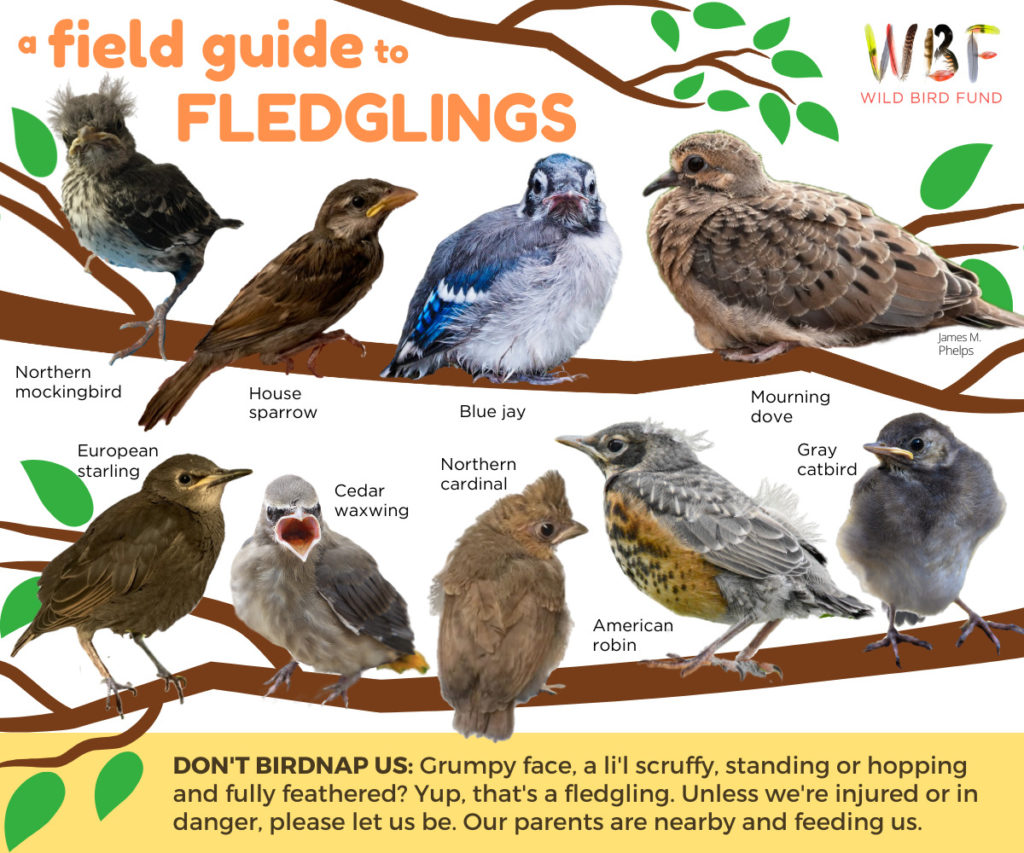
Fledgling birds are young birds that have left the nest but are not yet able to fly. It’s a normal stage of development for most birds, and it can be a very vulnerable time for them.
Typically the parents will come and feed the fledgling every 15-30 minutes, please don’t intervene prematurely. Songbird fledglings eat very frequently. Remember to watch from a distance so as not to deter the parents from returning.
Most fledglings are totally fine on their own, but if it seems in a dangerous spot, its ok to move it to a more sheltered/shaded location (within eyeshot of where it was found).
Image: A Field Guide To Fledglings, by “Wild Bird Fund”
Please find out what type of bird it is: e.g. songbird, raptor/bird of prey, water bird or other.
There are great online tools for bird ID, e.g. All About Birds.
If you are unsure, you’re welcome to send us a picture and we’ll be glad to assist in telling you what you have in front of you: info@interiorwildlife.ca.
Now locate the appropriate facility to contact:
- For waterbirds:
Please read our info on how we admit water birds such as ducks, geese, herons, swans, loons, cranes, pelicans, gulls and killdeer (bird in photo above): interiorwildlife.ca/found-injured-or-orphaned-wildlife
For songbirds:
The BC Wildlife Park has a rehabilitation department in Kamloops.
Phone: 250-573-3242 (ext. 230). Open 9-4 any day of the week.
Find more info here: https://www.bcwildlife.org/injuredwildlife.htm- For raptors (incl. owls, eagles, hawks):
Please contact SORCO in Oliver: https://www.sorco.org/
Now organize transport:
All wildlife rehabilitation facilities in BC rely on the public to transport animals in need to them, as we operate mainly with volunteers and have only enough human resources to tend to the animals brought in. We generally have no pick-up service. No wildlife ambulance exists.
Note: The public is legally only allowed to keep wildlife in distress captive for up to 24hrs.
Waterfowl, waders and shorebirds (incl. herons, swans, pelicans, cranes, loons, grebes, killdeer, gulls, ducks, geese) may need help, if you see:
Please email us for further directions on next steps: info@interiorwildlife.ca |

Eurasian Collared Dove (non-native),
Mourning Dove (native)
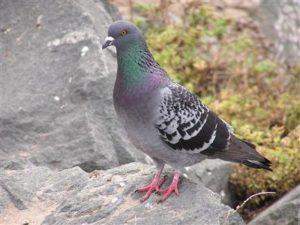
Rock Pigeon (non-native)
Please note our permits do not allow us to rehabilitate non-native species (rock pigeons or Eurasian Collared Doves).
REPTILE FAQs:
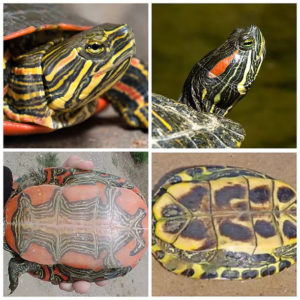
Reptiles including turtles may need help, if you see:
- Obvious wounds or bleeding
- Cracked shell
- Improperly positioned limbs
- Accidentally dug up or uncovered during the winter or when temperatures are below 10 C
- Bit by a pet
- Swallowed fish hook
Turtle identification:
– Red-eared Sliders (two images on right = invasive!)
Sliders can be identified by the red ‘ear patch’ on their heads & a blotchy, dull yellow plastron (see belly in bottom right image).
– Painted Turtles (the two images on left = native) have vibrant red colour on their plastron (see belly in bottom left image).
Images: Okanagan Similkameen Stewardship (www.osstewardship.ca/turtles)
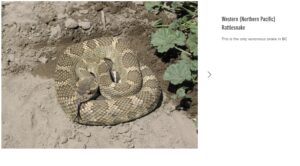
Reptiles including snakes may need help, if you see:
- Obvious wounds or bleeding
- A disturbed hibernaculum
- Accidentally dug up or uncovered during the winter or when temperatures are below 10 C
- Bit by a pet
Snake identification:
Go to www.osstewardship.ca/snakes and ID the snake. Do not touch if you are at all unsure what type it is.
Image: Rattle Snake by Okanagan Similkameen Stewardship Society (only venomous snake in the Okanagan)
Education is key
Have a question not mentioned above?
Email us and we will do our best to help you in a timely manner
For potentially orphaned baby wildlife, please click on each type of question above to ensure the animal gets the care they need and is not accidentally removed from their mothers. Rehabilitation centres work hard to make sure nobody drops off a “kidnapped” baby wild animal. Generally, wild baby animals have the best chance of survival with their parents. This is especially true for deer fawns, young rabbits, nursing raccoons and quail chicks.
ask questions. find a solution. be kind.
How to Donate
IWRS is 100% volunteer-run. We are funded solely by private donations and sponsorships. As as registered charity, we can provide tax receipts for your donation!

Donate online
E-transfer us directly: donate@interiorwildlife.ca
or by credit card via Paypal
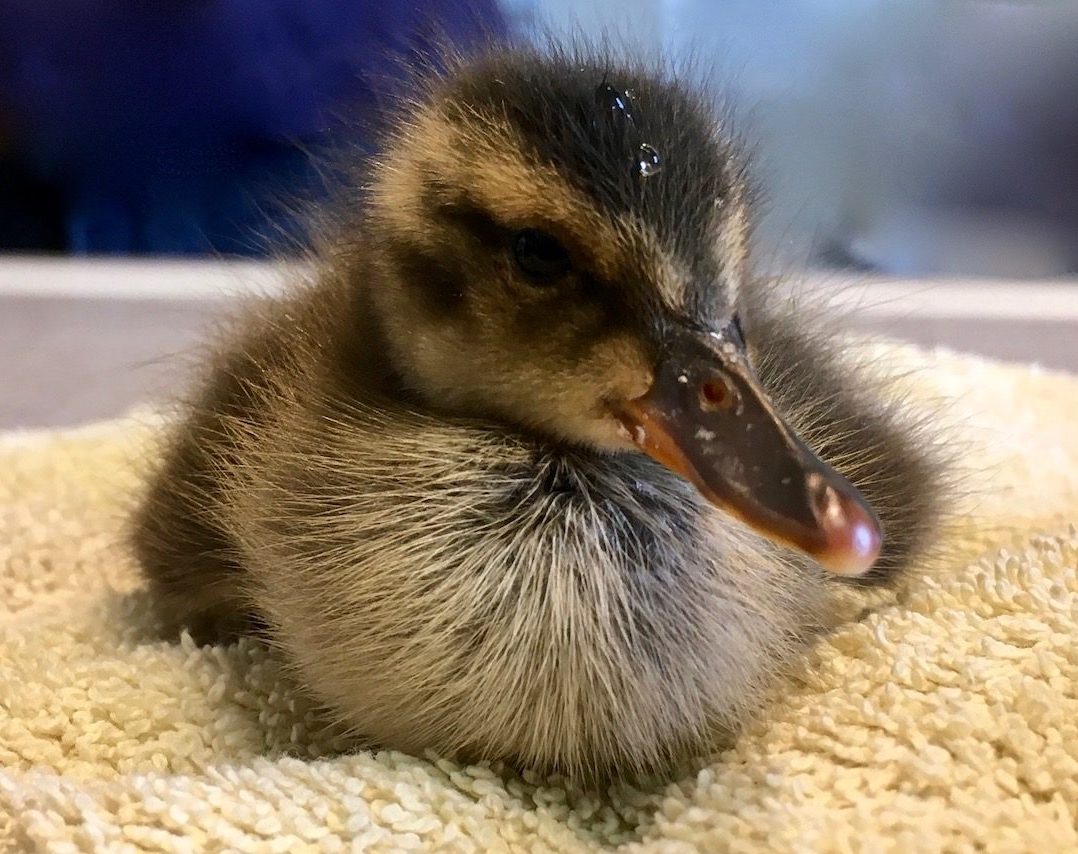
Mail a cheque
Office address:
PO Box 988
V0H1Z0, Summerland,
BC, Canada

Via Canada Helps
Click above or below to get re-directed to our charity account with CanadaHelps.org
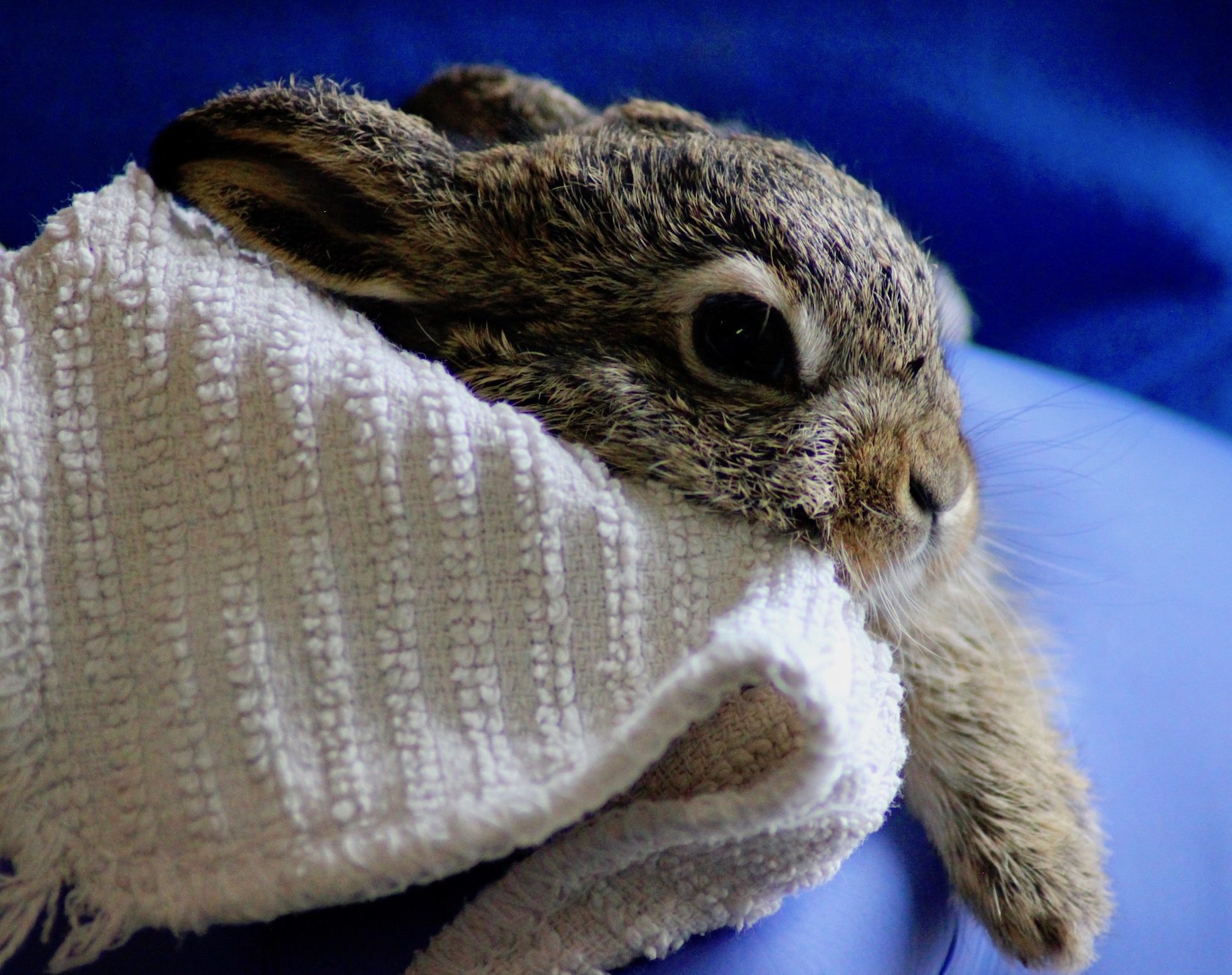
Wish Lists
Click on the picture above
and view our in-kind and gift wishes


